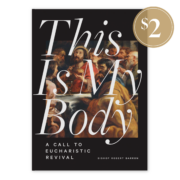A large aquarium with colorful, exotic fish was recently installed in the lobby at Mary Immaculate School in Farmers Branch, Texas, as part of an initiative to place wonder at the center of education. I’ve heard it’s a great success. The aquarium is an ingredient in helping Mary Immaculate fulfill its Gregory of Nyssa–paraphrased motto: “Where wonder leads to knowing.” Teachers and parents already see this when the students rush into school to marvel at the fish. Like all encounters with what Adolf Portmann called “the familiar mystery of living things,” the fish put the students in the proper contemplative, reverential mood that’s key to a successful school day. Mary Immaculate is one of many schools prioritizing the contemplative dimension of education as key to a good education, and all Catholic schools should take note.

While still a traditional parochial school, Mary Immaculate is part of a burgeoning educational movement that has been sweeping across the country for the last fifteen years, putting wonder and beauty at the center of their philosophies. Catholic classical schools are perhaps most representative of this trend. But many people have yet to encounter what I see as the blueprint of the educational vision guiding many of these schools: The Educational Plan of St. Jerome Classical School in Hyattsville, Maryland.
In 2013, CNN published an article titled “Classical Schools Put Plato Over iPad” on St. Jerome’s Academy and the growing popularity of classical schools, detailing why parents are opting for them over others. Administrators worried about the future of K–12 Catholic schools—and yet willing to try something other than the standard secular-education-with-a-religion-class-on-offer that characterizes most Catholic schools—ought to read this article. And while the classical route is not for every school, this piece will at least encourage schools to teach by way of beauty. The Educational Plan of St. Jerome Classical School gives you the theory and praxis to make that happen.
The plan’s main author was my former graduate professor Dr. Michael Hanby, Associate Professor of Religion and Philosophy of Science at the Pontifical John Paul II Institute at the Catholic University of America.
While Dr. Hanby does not have professional degrees in education, his comprehensive understanding of Catholic tradition has enabled him to articulate just the educational philosophy Catholic schools need, paving the way for education renewal. His many articles on the malaise in contemporary education and the need to resist “the pressure of scientific specialization and utilitarian vocationalism” are in line with the insights of famous Catholic educationalists like Stratford Caldecott, Christopher Dawson, and Luigi Giussani, pointing teachers to the “spiritual unity” out of which the beauty of Catholic culture arose with practical tips on how to awaken students to that beauty. In many respects, Mary Immaculate seems to be heeding his advice.
Contemplation is the telos of education, contemplation ultimately of the Face of God as disclosed in Jesus of Nazareth.
The plan is very much indebted to the rich ressourcement movement that retrieved for the contemporary Church the great Christocentric vision of the Church Fathers. Bishop Robert Barron is very influenced by this movement, making the plan, in many ways, Word on Fire’s educational vision. Consider the wonderful preface quote to the Educational Plan, which comes from Hugo Rahner (the brother of the famous Karl Rahner), paraphrasing St. Justin Martyr, and you’ll see what I mean:
All that is good and true has proceeded from the Word and has its homing point in the incarnate God, even though this be hidden from us, even though human thought and human good-will may not have perceived it. . . . For the humanist Christian there is only one possible attitude that he can take towards the world: he must love.
This preface evokes the first principle of the Word on Fire movement: “Unwavering Christocentrism.” Accordingly, all education is but a gradual leading out toward the Gestalt (form) of Jesus Christ that we receive in faith by way of revelation. Contemplation is the telos (end) of education—contemplation ultimately of the Face of God as disclosed in Jesus of Nazareth.
The principle of “leading with beauty” is found in the plan’s illuminating definition of education:
True education has always rested on two presuppositions. The first is that truth is desirable for its own sake. It is good not for what it does, but for what it is. The second is that knowledge consists not in bending the truth to ourselves, but in conforming ourselves to truth. We can only conform ourselves to truth by freely embracing and loving it, and we can only love truth if we are enticed by its beauty. Love of beauty has therefore always been integral to the discovery of truth and true education has always sought to form the heart and mind, reason and will, desire and knowledge. In short, education forms the whole person in light of truth, beauty, and goodness.
These quotes may seem rather abstract, but the plan offers very practical advice, from field trip ideas to the right colors for classroom walls. The teacher resources are one of its best parts. I have bought nearly all the recommended books. And I have found myself frequently consulting its fifteen questions when developing lesson plans.

As Word on Fire’s Fellow of Catholic Education, I see it as my duty to tell as many teachers as possible about this plan. It is one of the best-kept secrets in the educational world. And while there’s still a great need to coach teachers and administrators in how to effectively implement its vision in the schools, the first step is to spread the word that such a vision already exists.
St. Jerome Academy was like many parochial Catholic schools. Enrollment was down, and the administration was ready to hire an educational “expert” who would likely pitch the latest trend. Instead of going down this route, the school chose to take a risk and implement this plan. It worked; enrollment went up, and they recently opened the St. Jerome Institute, a Catholic high school built on the same plan.
As I said before, schools do not have to completely take up this plan. But they should try to incorporate some of its principles, like “leading with beauty,” as best they can. A good place to start is with an aquarium full of exotic fish.
